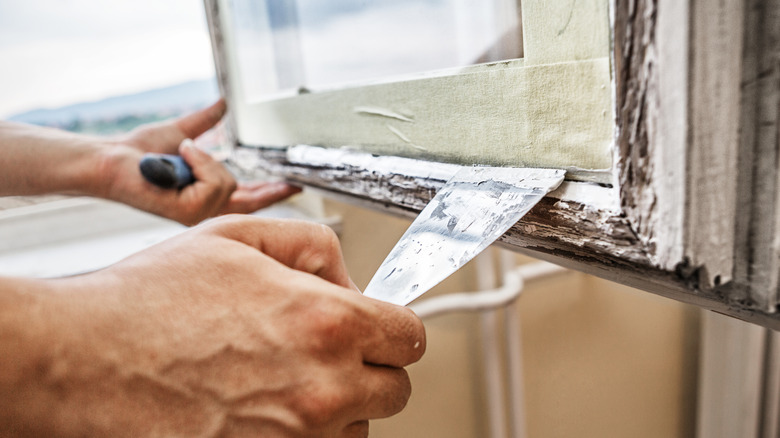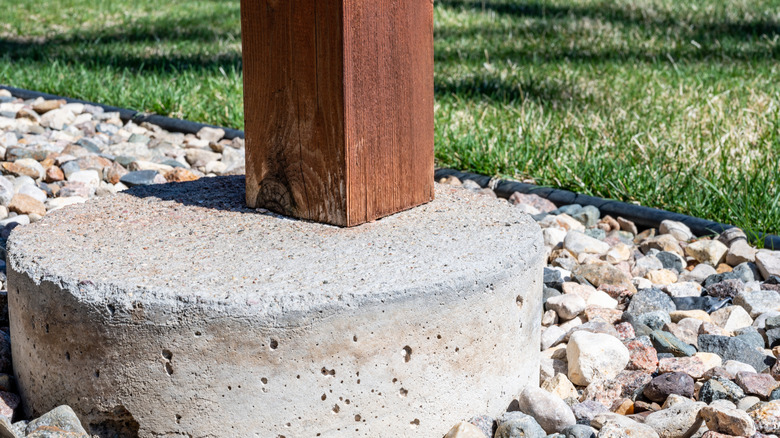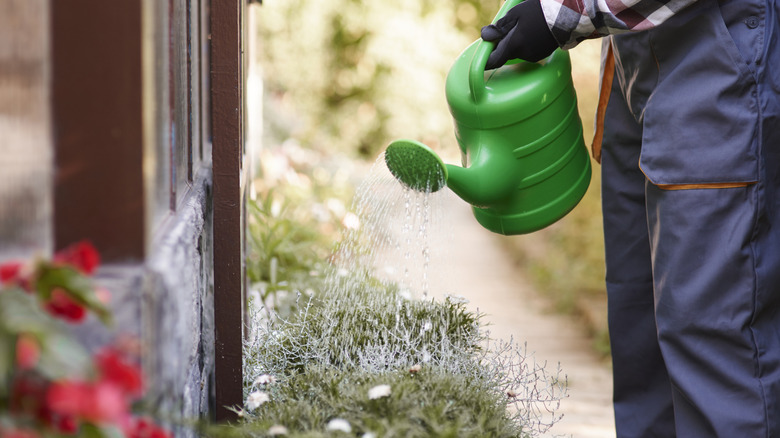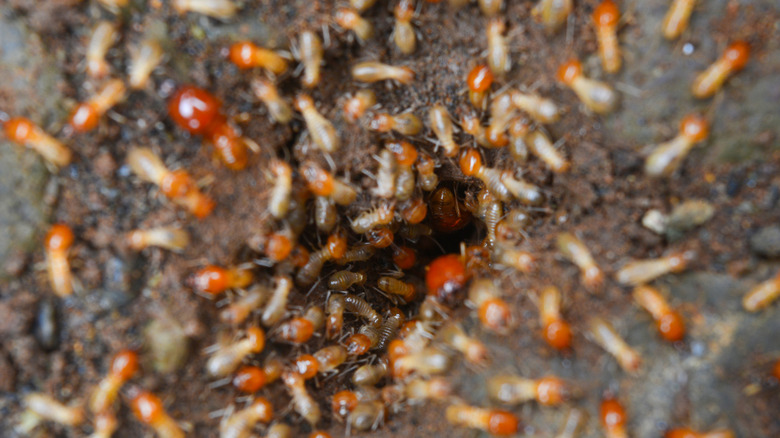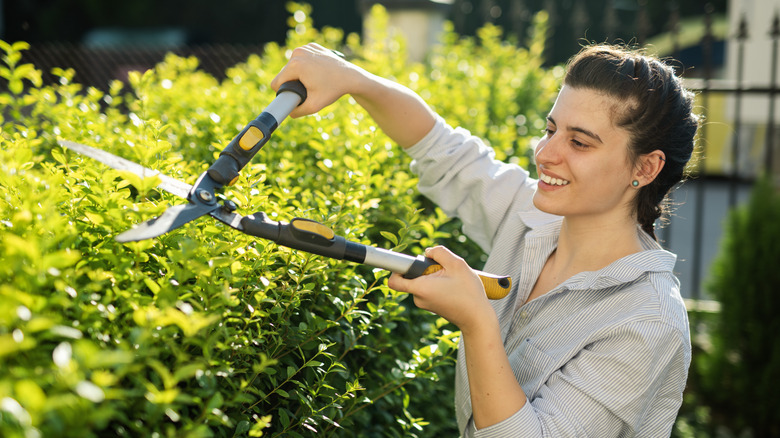12 Non-Toxic Solutions For Preventing Unwanted Termites In The Home
The sight of a winged insect or two along the baseboards can send a shudder into even the most experienced homeowner's heart. After all, an actual termite infestation raises an immediate quandary. You want to keep the insect pests from doing serious damage to your home. But at the same time, you dislike the idea of pumping chemical gases throughout the house, so you want to get rid of termites without tenting.
To determine where the pests might be doing the most damage, it's important to learn the types of termites most linked to your region. The most common type of termite, the subterranean species, prefers to live underground, but will go into a building for food (mostly wood) and moisture. Dampwood termites seek out moist, rotting wood, whether it's an old stump or a home with soft spots. Drywood termites don't dwell underground at all, instead preferring to both live and eat in wooden structures and wooden furniture.
Depending on the species, you'll be looking for surefire signs you have a termite infestation, which include swarms of the actual insects and mud tubes on walls, which they use as tunnels for traveling. To tackle the issue head-on in the most earth-friendly way possible, start by eradicating their most obvious points of egress into the home. Then move on to non-toxic control methods. For serious infestations, consider talking to professional exterminators. They may be "greener" than you think when it comes to using non-toxic ways to prevent termites!
Play outdoor detective by seeking out termite habitats
Removing the termites' main hangout is one of the first ways to get rid of termites that you can try. Nest removal discourages termites from foraging closer to your home. Look for telltale signs in nearby stumps, garden bed walls, landscaping timbers, dying trees, and other woody culprits. They may also go after non-woody plants in your garden. Think about areas which are likely to provide both moisture and cellulose, the compound found in plant cell walls. Keep an eye out for damaged wood or plant parts, and also for the termites themselves. Dampwood and subterranean termites will emerge after rainfall. Discarded wings, sawdust, mud tubes — and of course damaged wood — are signs of various termite species.
Even if you don't ultimately find their nesting spot, removing potential habitats near your home is also important. Again, consider tree stumps, woody mulch, weakened or dead trees, and old landscape timbers as current or future habitat termite habitats. Also look for garden and potted plants which look as if their stems and roots are spotty or hollowed out. (If leaves or flowers are also eaten, chances are termites are not the culprits.) Destroy these nesting possibilities, and replace them with new versions wherever possible.
Repair, replace, and reinforce wooden parts of your home's exterior
The typical wood-frame construction of an American home has plenty of charm — and plenty of ways for Mother Nature to ease her way in. From siding to soffits, trim to trusses, and posts to porches, chances are at least some of these elements in your home are made of wood. Over the years, wood can become softened by rain, snow, and interior leaks. It can also crack as the foundation shifts. All of these factors leave openings for termites and other pests to enter and do serious damage.
Wood that has already been riddled by termites should be removed and replaced. If you're especially concerned about toxic fumes from treatment, ask your builder about the feasibility of using naturally resistant timbers, such as cypress or cedar. You may also choose to use non-wooden trim or siding for replacement. To repair wooden home parts, remove and replace rotted sections, or seal after adding some wood filler. For the remainder of the wooden exteriors, especially near the ground, touch up the wood with paint or sealant.
Set down non-toxic barriers during a new build or renovation
Are you building a new home or rehabbing your house? This is the ideal time to install non-toxic measures that still have industry-improved termite prevention characteristics. The main goal is to install barriers made of non-toxic materials. These are safe for humans, but termites don't want to cross them.
One key building product is made out of stainless steel mesh, designed specifically to prevent termites from entering or eating through them. It can be wrapped around all pest entry points, including posts, pipes, vents, and foundations. Another potential method, for both new construction and existing homes, is to establish a sand trench about 4 inches deep and 20 inches wide that extends around the entire foundation. Ideally, the sand would be 16-grit. In addition, finely ground stone particles can be laid around foundation footers. You could also consider having metal foundation shields installed or place masonry caps on the footers of new foundations.
In addition to putting barriers around your house, get out the caulk gun! Make it as hard as possible for termites to enter your home's exterior, as well as to travel very far if they do breach the perimeter. Caulk foundations and masonry, as well as moist areas around kitchen sinks, bathroom sinks, toilets, and bathtubs.
Reduce moisture both outside and inside your home
Yet another reason why water leaks in your home shouldn't be ignored: Termites are drawn to moisture because their soft bodies are vulnerable to dehydration. That means that when they seek access to your house, they're craving both food and water. Make your home less attractive to them by inhibiting any signs of leaking and excess moisture. Leaky pipes and gutters also lead to damp and rotting wood, which additionally attracts termites. Take measures to have these moisture traps repaired or removed.
Don't forget to inspect for exterior leaks. Are your gutters and downspouts in poor condition? Are garden hoses and irrigation systems dripping even when not in use? In addition, consider whether any siding or trim needs to be patched so that the interior walls aren't open to the elements. Seal up or replace windows that regularly fog up or have softened sills. Finally, have an inspector look at damp walls or musty, moldy areas to see if you have pipe or ventilation issues. Problems like these can occur anywhere in your house, from crawl spaces to walls in which pipes are running through. Even a leaky roof can attract ground-dwelling termites, because eventually the water damage permeates lower levels of the house.
Remove soil-to-wood contact around the house exterior
Termites, whether they're one of the naturally subterranean species or just using the soil to travel, are tempted by places in which your home's wood finishes come in contact with dirt. Getting rid of these points of contact can do much to keep termites from entering and feasting on your home's exterior and interior parts.
There is a simple checklist of ways that you can minimize soil-to-wood contact. Start by replacing ground-level wood wherever possible with non-wood trim or with treated wood. When establishing wooden posts, embed them in concrete footers. If you don't wish to do that, consider digging away the ground around your home's exterior so that the gap between soil and wood is at least 6 inches. You might also consider replacing some of the soil with sand or finely ground stone. Finally, make sure that wooden trim and other wooden elements near the soil are regularly stained or painted so that the earth's moisture doesn't soften the wood.
Relocate log piles, mulch, and other pulpy temptations
As convenient as it is to have your woodpile and recycling areas right next to your home, that convenience can come back to bite you — or rather, your home — where it hurts. After termites finish snacking on the pulpy material set near the house, they'll move on to the building itself. The same goes for woody landscaping materials like mulch and timbers that offer visual appeal and weed control, but also lure pests directly to your front door. If you're in the process of building a home or extension, make sure the builders and landscapers don't leave old stumps and roots in the ground.
To start Operation Go Away, move any stored cords of wood stacked against your exterior wall. These often play host to termites, carpenter ants, and other pests that then climb out from the pile and into your walls. Make sure the woodpile is at least several feet away from exterior walls. Similarly, don't store to-be-recycled materials like cardboard, newspaper, and paper grocery bags near the house. These have a way of getting forgotten, eventually turning into a pest haven. In addition, thin out woody mulch around foundation plantings so that it's not actually touching the house. Finally, don't set up timber-framed flower beds right against your foundation. Both the piled soil and the wood itself will lure termites.
Release the nematodes!
Beneficial nematodes are tiny roundworms that feed on insect pests such as termites. They're readily available from garden centers and mail-order sources. Nematodes won't work on the termites that are already invading your home. But when you spot signs of an infestation around the landscaped areas near your foundation, nematodes can be a useful way of stopping those termites in their tracks. Establish the tiny termite eaters in the soil surrounding your home as one of many methods of non-toxic pest prevention.
It's important to get the right nematode species for your situation. Read labels carefully before buying. Some species are better for the kind of hardened, clay surface you might have around parts of your house, while others work better in cultivated garden soil. (You'll also want to make sure to get the kind of product labeled "beneficial nematodes" as opposed to "nematode control," which kills "bad" nematodes.) Mix the package contents with water at the recommended rates. Pour this solution into the soil near your home with a watering can. Work the nematode solution into the freshly dampened earth, preferably in the morning. Again, follow label instructions for amounts needed per square foot.
Use liquid bait traps to keep poisons contained to the termites
Not all insecticides pose direct threats to humans or to the environment. Application methods and the actual formulation make a big difference in the level of toxicity. For example, liquid bait designed to kill termites is set inside contained tubes filled with small amounts of insecticide. Given the contained nature of these traps, they are considered non-toxic to humans, pets, and other large animals. Be aware, however, that bait traps are seldom a magic bullet when it comes to termites and their habitats. They should be used in conjunction with other control measures, because the termites need to find these liquid bait stations themselves before they prove effective.
Although liquid bait is toxic to termites, institutions such as the University of Florida's extension service list the traps as among the "least toxic control" options. You can find these trap stations online and place them yourself, or use an exterminator to expertly place them. The baits are filled with insect growth regulator insecticides. Termites are then drawn to the bait as they're foraging for food in the soil, then killed after ingesting the bait. You may need to replace the bait stations, especially if they draw competing termite colonies.
Mix termite-repelling plants into your landscape
Studies indicate that at least two herbs can play a part in "turning off" foraging termites. These herbal plants emit scents that seem to repel the pests. Use this landscaping strategy as one aspect of your overall termite-prevention strategy. Along with growing these plants around your home, consider gathering fallen or pruned foliage from the herbs and tucking them around the foundation to further extend their repellent properties. For best results, plant them in large groupings near vulnerable areas of your home.
Herbal plants are particularly useful because they can blend in with a traditional herb patch or rub elbows with perennial flowering plants. Herbs with termite-repelling properties include mint catnip (Nepeta cataria) and lemon thyme (Thymus citriodorus). Catnip, which thrives in zones 3 to 7, grows about 2 or 3 feet tall and wide, and has frothy-white blossoms. Mix it in with your foundation plants, or set it in the kitchen garden near your back door. Lemon thyme is lower-growing, seldom reaching more than 12 inches high. There are also creeping varieties that can be set between paving stones. It does best in zones 5 to 8. Enjoy the plants' lemony scent and purple blooms, while knowing that they may be keeping termites from crossing their path. Aloe vera may also be useful when smeared on vulnerable wood. Grow the spiky plant in pots in your kitchen or patio, and use the aloe vera gel to help keep termites out of your home.
Thwart termite travel by landscaping strategically
Along with what you grow near your foundation's exterior, how you landscape is just as important when it comes to preventing termite infestations. Different termite species prefer to travel via different routes. That means you'll need to pay attention to both soil-level landscape issues as well as those of taller plants. The mulching, pruning, and planting decisions you make now can help deter pests like termites in both the long term and the short term.
Even non-woody mulch can be a termite beacon — if it's set too thickly against the foundation. That's because mulch makes the soil beneath it so moist that termites will flock to that area. Make sure to let your mulch of choice peter out several inches from the actual trim or foundation. Similarly, don't plant bushes or flowers right up against the home's exterior walls. Not only can termites climb these to gain entry to wooden siding or trim, but it also eliminates your ability to dig a preventative trench around the home. Strategic pruning of trees and shrubs is another crucial termite blocker. Keep branches from touching your home's roof or siding, so that termites and other pests can't climb from the branches to the home itself. In addition, consider trimming foundation shrubs so that they're wider at the top than the bottom. This "V" shape reduces shadows and moisture at ground level -– both things in which termites delight.
Try a few home remedies on termite swarms
It can be difficult for non-professionals to reach all the areas that termites might be infesting. Yet some natural products can be tried on the swarms or damage homeowners do find. One example of a DIY modification involves using borax as an anti-termite spray or paste. Exterminators and home builders use borates to treat wood for termite prevention. Homeowners may have some success by making a slurry from commercial sodium borate (Borax) and water, then painting or spraying the slurry on vulnerable wood. The small quantity at which you would use borax is safe for humans and other mammals, but deadly to many insect pests, including termites. (Of course, using protective eyewear and clothing when applying is always smart.)
Orange oil has also been found to be effective in killing termites on contact. This oil trick can help get rid of termites naturally (though you might not love it), so it can be useful as part of your overall plan in preventing some termite damage. Spray orange oil onto swarms that you can see, or inject orange oil into vulnerable wood. Another non-toxic substance you can try is diatomaceous earth, or DE. DE has a dehydrating effect on drywood termites, and can be dusted onto wood as it's being placed onto new construction or a renovation. As a control measure, you can also sprinkle a barrier of it around your home and your garden, so that it kills the termites that cross it. Reapply after rain.
Set out cardboard traps
It's normally a bad idea to keep flattened cardboard near your home, because that pile actually draws termites and other pests that love to chomp down on the cellulose material. It's a bad idea, that is, unless you're leaving the boxes there deliberately, as a termite trap. Of course, this method won't work if your home is already riddled with termites. But if you're just starting to see the signs of these pests in your gardens and near the home's exterior, a cardboard trap may help keep a small problem from becoming a big one.
At a minimum, the cardboard trap method can be part of your overall non-toxic system that helps you identify which termites are pestering your home. Start by flattening and wetting down a few cardboard boxes. Allow some time to pass so that the initial termites leave a pheromone path for the rest of the colony to find. Watch for infestation, and then regularly destroy the inhabited traps before setting down freshly dampened cardboard. Bag up and dispose of the infested cardboard carefully.
Seek out professionals who've gone green
Exterminators are increasingly listening to residents who can't control termites on their own, but who still want to use minimal chemicals to get rid of them. Increasingly educated homeowners are aware that the traditional tenting method to kill termite infestations uses noxious greenhouse gasses like sulfuryl fluoride. When you're talking to local pest control services, ask if they use the least-toxic methods possible. (The websites of earth-friendly companies are also likely to mention this commitment.)
Specifically, talk to your exterminator about whether they use natural compounds like pinenes, which are derived from trees. The pinene attracts termites to specific areas of the home, so that they are easier for professionals to locate. Once the termites are clustered in one area, the exterminators inject insecticides that are safer, because they are drilled into wood rather than applied as a gas. Some companies are also experimenting with wintergreen essential oil. Unlike other termite-repellent natural compounds, such as orange oil, wintergreen oil stands up to the accompanying heat treatments that professionals use when blowing air inside your home's walls and vents.


